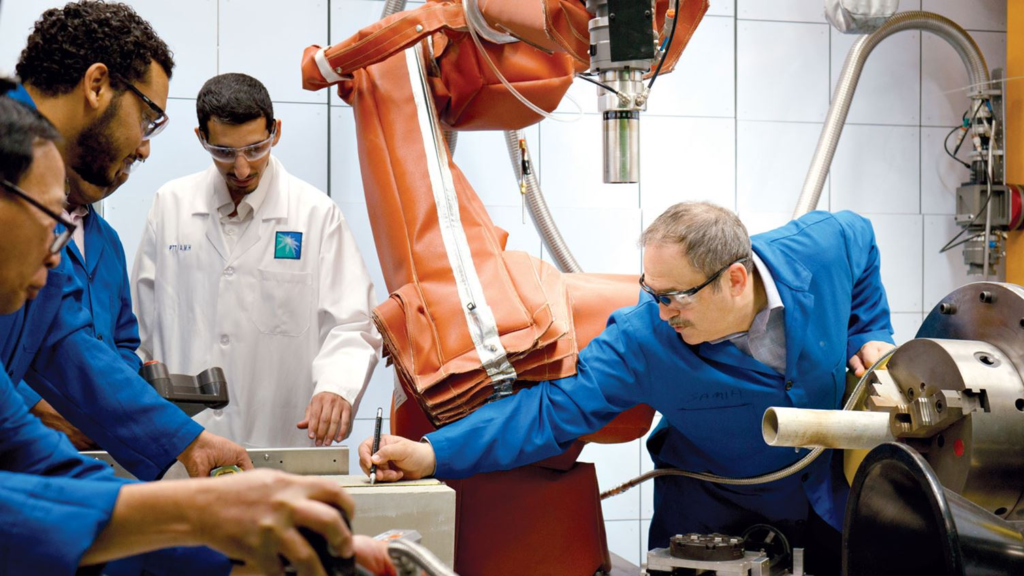Innovative upstream laser technology

Saudi Aramco is committed to pursuing solutions that allow the company to unlock resources in new ways, using methods that are flexible, efficient, and help preserve the environment.
This commitment has led the EXPEC Advanced Research Center (EXPEC ARC) to establish the Upstream High-Power Laser Laboratory — a state-of-the-art and cross-disciplinary research facility for subsurface photonics. In this facility, skilled young Saudis will collaborate with scientists from around the world to solve the upstream challenges of the future.
A promising area of research
Subsurface photonics is a promising area of upstream research that will become crucial for the future of the recovery, and production of hydrocarbons. In this field, collaborations are essential to promote innovation and success. Therefore, during its first years of operation, the laboratory began partnerships with renowned institutions — in-Kingdom and around the globe — to design novel optical fibers, create innovative laser sources, and lead the development of downhole laser tools.
“All of us at Saudi Aramco are working toward the same goal — to remain the world’s most reliable supplier of energy. It’s a responsibility we take very seriously,” said Nasir K. Al Naimi, vice president of Petroleum Engineering and Development. “In that sense, laser technology is a game changer for the oil and gas industry. It allows us to harvest the power of light to unlock petroleum resources with unprecedented efficiency, reliability and adaptability. It is a powerful solution for the future.”
The traits of laser technology make it versatile and adaptable to numerous applications in the oil and gas industry. It brings many advantages over traditional methods for drilling and workover: a higher rate of penetration, reduced costs for tripping, casing, and bit replacement. It also requires a smaller surface footprint, compared to current drilling and stimulation systems; and is a waterless alternative to fracturing.
Small footprint, compact, economical, moveable, sporadic maintenance, directional, and waterless — these are the essential elements for a healthy and environmentally friendly technology.
“We are building capabilities, training young Saudi researchers on high-power lasers, probing new means to guide the interactions between light and rocks, and matter in general. Our research encompasses many areas of photonics and petroleum engineering, along with fundamentals, applications, and the operation of the system,” explained Sameeh Batarseh, laser program team leader with EXPEC ARC’s Production Technology Division.
The power of lasers
A high-power laser beam can melt or vaporize rocks, depending on the beam’s energy and the rock’s properties. For example, the light can be controlled to vaporize stuck pipes or drill rocks; the latter avoids fishing or well deviating, the former prevents melt and reduces material disposal.
When a laser beam impinges on a rock, a portion of the incident energy is absorbed and transformed into thermal energy. As a result, the stone heats up, and what follows depends on the energy flow and its intensity.
“In the past, we characterized the effects of high-power laser irradiation on rocks, we identified mechanisms to control the energy flow, and determined potential applications,” Batarseh explained. “We proved that laser and laser-assisted technologies are a non damaging, flexible, and cost-effective alternative to drilling, completion, and stimulation of oil and gas wells.”
To prove the concept, various rock types were first irradiated with high-power lasers and later meticulously examined. The experimental data demonstrated that high-power lasers could cut and bore rocks at ambient pressure, and that high-pressure and stress enhanced the laser’s ability to perforate reservoir rocks.
This equipment will allow the team to create downhole environmental conditions in the lab and test new scenarios and techniques.
Field trials
In the field, the team is planning to use a similar laser system and optics to those in used and developed in their laboratory. Yet, to attain the final goal, the laser beam should transmit with little optical loss over tens of kilometers underneath the earth, enduring a harsh environment, before it can reach the laser head and hit the rock.
Optical fibers will be used to transmit the high-power laser beam from the surface to the subterranean target.
This requires an unprecedented innovation in optical fiber technology. It is an ambitious endeavor — its outcome a suite of solutions, capabilities, and breakthroughs that will make Saudi Aramco the leader in high-power laser delivery for downhole applications.
The team at EXPEC ARC is currently investigating innovative concepts, optical fibers, and materials that will create the first ultra-low-loss and long-length optical fiber for high-power laser delivery.
“EXPEC ARC has maintained a steady perseverance in acquiring the most sophisticated tools and resources to support our strategy: develop high impact technologies for our proponents. The addition of the laser lab to our facilities is the result of an extensive, dedicated, and influential research, which has proven to be of high impact and value to Saudi Aramco’s upstream business and future. The products of this research have the potential to change the way the industry unlocks reserves in conventional and unconventional reservoirs,” said Ali Al-Meshari, EXPEC ARC manager.




 Email: info@cyber-gear.com
Email: info@cyber-gear.com